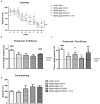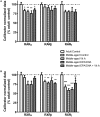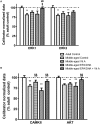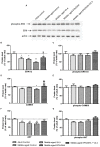EPA/DHA and Vitamin A Supplementation Improves Spatial Memory and Alleviates the Age-related Decrease in Hippocampal RXRγ and Kinase Expression in Rats
- PMID: 27242514
- PMCID: PMC4860397
- DOI: 10.3389/fnagi.2016.00103
EPA/DHA and Vitamin A Supplementation Improves Spatial Memory and Alleviates the Age-related Decrease in Hippocampal RXRγ and Kinase Expression in Rats
Abstract
Studies suggest that eicosapentaenoic acid (EPA), docosahexaenoic acid (DHA), and vitamin A are critical to delay aged-related cognitive decline. These nutrients regulate gene expression in the brain by binding to nuclear receptors such as the retinoid X receptors (RXRs) and the retinoic acid receptors (RARs). Moreover, EPA/DHA and retinoids activate notably kinase signaling pathways such as AKT or MAPK, which includes ERK1/2. This suggests that these nutrients may modulate brain function in a similar way. Therefore, we investigated in middle-aged rats the behavioral and molecular effects of supplementations with EPA/DHA and vitamin A alone or combined. 18-month-old rats exhibited reference and working memory deficits in the Morris water maze, associated with a decrease in serum vitamin A and hippocampal EPA/DHA contents. RARα, RXRβ, and RXRγ mRNA expression and CAMKII, AKT, ERK1/2 expression were decreased in the hippocampus of middle-aged rats. A combined EPA/DHA and vitamin A supplementation had a beneficial additive effect on reference memory but not in working memory in middle-aged rats, associated with an alleviation of the age-related decrease in RXRγ, CAMKII, AKT, and ERK1 expression in the hippocampus. This study provides a new combined nutritional strategy to delay brain aging.
Keywords: hippocampus; kinases; n-3 long-chain PUFA; retinoid receptors; spatial memory; vitamin A.
Figures






References
-
- Alfos S. (2014). “Fish oil supplementation prevents age-related memory decline: involvement of nuclear hormone receptors,” in Omega 3 Fatty Acids in Brain and Neurologic Health 1st Edn eds Watson R. R., De Meester F. (San Diego, CA: Elsevier; ) 147–161.
-
- Armbrecht H. J., Siddiqui A. M., Green M., Farr S. A., Kumar V. B., Banks W. A., et al. (2014). SAMP8 mice have altered hippocampal gene expression in long term potentiation, phosphatidylinositol signaling, and endocytosis pathways. Neurobiol. Aging 35 159–168. 10.1016/j.neurobiolaging.2013.07.018 - DOI - PMC - PubMed
LinkOut - more resources
Full Text Sources
Other Literature Sources
Research Materials
Miscellaneous

